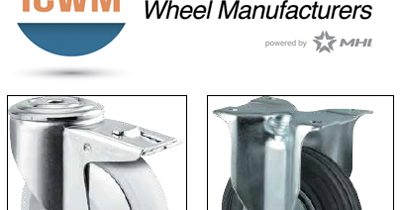SAFER HANDLING: Selecting the Right Casters and Wheels for a Safer Roll
Article from MHI Solutions Magazine
Members of the Institute of Caster and Wheel Manufacturers (ICWM) supply caster and wheel solutions worldwide for major manufacturing and distribution sectors. Their products are connected to all kinds of equipment used to move items around warehouses and manufacturing facilities and other work environments including hospitals and grocery stores. Selecting the right casters and wheels can create a safer environment for workers.
Rollability
When selecting wheels, how much weight workers will be pushing and a safe push/pull force must be determined, explained Dave Lippert of MHI member Hamilton Caster. This data is available free from both Liberty Mutual’s ergonomic tables and The Ohio State University Spine Research Institute. While larger diameter wheels made of harder materials are generally easier rolling, consult manufacturers for data specific to your situation. Absent specific company criteria, Lippert suggests workers use no more than 40 pounds of force.
Other important factors to consider in wheel selection are the nature of the surface (concrete, carpet or linoleum) and the environment (inside, outside or wet) where the wheels will be rolling, said Natacha Smith of MHI member TENTE Casters, Inc. Wheels can be made in various diameters, thicknesses and materials, like rubber and polyurethane. What is appropriate depends on what is being pushed and where the wheels are being used.
Some MH facilities have floors in poor condition or covered with debris, Lippert said. This makes it hard to push things. So an appropriate wheel with the proper tread is necessary to prevent wheels from suddenly locking up and potentially injuring the worker pushing the device.
Casters are frames or rigs around wheels. They can be supplied with brakes, which are generally “designed to keep a stationary load from moving when parked on a level surface,” Lippert said. “Don’t expect brakes to be capable of stopping or slowing a moving load unless they were specifically designed for this purpose.” The wheel type must also be considered, as some wheel tread materials can be somewhat slippery and harder to secure with brakes.
Swivel locks turn swivel casters, which are designed to move in all directions, into rigid casters that move only in a straight line. These locks can help when maneuvering in tight spaces when disengaged and then can be reengaged when going down aisles.
View full article in MHI Solutions Magazine





